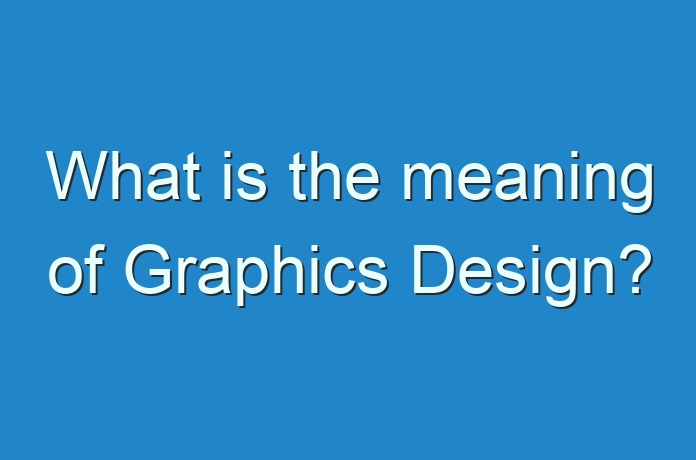
Graphic design has developed from basic artistic and design techniques such as drawing, typography or printing, and uses all available visual media for its representations. Modern graphic design still has an artistic, but also a practicable and descriptive claim.

The working methods of graphic design are also used for technical representations. Among other things, an attempt is made to make a certain message clear to a viewer in a particularly simple and easy-to-understand manner using graphically designed elements such as pictograms, logos and small sketches. Before moving forward we will discuss a brief history and also what is the meaning of graphic design?
A brief overview of the history of graphic design
The term graphic design was coined in 1922 by William Addison Dwiggins . The oldest printmaking images known in Europe were made from hand-made drawings at the beginning of the 15th century using monochrome woodcut by monks and nuns in monasteries. These little pictures with religious motifs were sold to the faithful. The first newspapers and leaflets appeared between the 12th and 15th centuries, such as the Fugger newspaper. The first illustrations were shown in newspapers that appeared more or less irregularly. Since many people could not read or were barely able to read, these images were used to transmit a wide range of information for the first time.
With the invention of letterpress printing and the rapidly
spreading use of paper, further graphic printing techniques for the duplication of drawings and images, such as woodcut or copper engraving, emerged. Albrecht Durer, who lived from 1471 to 1528, was the best-known artist who created works that have always been considered masterpieces using woodcuts and engravings in the 15th and 16th centuries.
Further printing techniques were invented in the centuries that followed. The inventions of chemo technical printing processes gained further importance for the distribution of printed products all over Europe. Such a chemo technical process was, for example, the chemical etching of the printing plates on the etchings, which was already known in the 16th century, or the aquatint technique invented in the 18th century, as well as the lithography invented at the beginning of the 19th century. The scraping process from the 17th century made it possible to print larger colored areas.
The expansion of the book trade as well as press products and leaflets, the further development of processes for paper production and the various printing techniques also led to a further development of creative techniques and possibilities. Thus, the artistic forms of expression and the way of representation of the early graphic designers also changed.
Another major development for graphic design was artistically or politically motivated poster printing. The posters of the Parisian artist Toulouse-Lautrec, for example, became very famous.
Graphic design since the middle of the 20th century
The changes in the modern media world since the middle of the 20th century had a great impact on graphic design. In the years after 1950, the markets began to change from seller to buyer markets and advertising in the print media such as newspapers, brochures, posters and others grew more and more. Graphically designed elements were also increasingly used in television advertising.
The working methods of graphic artists expanded from the use of drawings, illustrations, typography, various printing processes to areas of photography and others. With the invention and the professional use of computers in the business world, the possibilities for graphic design have been enormously expanded once again since the 1980s. Desktop publishing and the creation of digital computer graphics using pixel and vector graphics changed the design options, but just as big changes also occurred in the technical communication channels.
Graphic design, information design, corporate design and media design became sub-disciplines of a comprehensive communication design. In today’s world, the perfect interplay of visual and communicative messages using all available media is becoming increasingly important, such as video and film.
The invention and the worldwide spread of the Internet have created the possibilities for interactive use between providers of websites and users. Contents and messages are increasingly being transmitted digitally and to the recipients through the deliberately designed mixing of text, graphics, images, sound, video and film. Corporate identity and corporate design have gained great importance for the advertising and public relations of companies and institutions.
The profession of graphic designer
The professional title of graphic designer is not protected by law. This means that anyone who wants to work as a graphic designer may be able to do so as a freelancer, in principle, if they get sufficient orders with their work, perhaps because of their own skills and knowledge. In order to get employment in an advertising agency or another company or institution, academic training is expected in the most common cases. Private and state universities and technical colleges offer training as graphic designers as bachelor’s and master’s degrees.
Another possibility of state recognition as a graphic designer is the three-year training courses at the vocational schools. Admission to these vocational colleges, universities of applied sciences and universities requires an entrance examination and the submission of a folder with various works by the applicant.
Career opportunities for trained graphic designers exist, for example, with advertising agencies or other companies in the rise to creative or art director. The courses in communication design and visual communication expand the fields of activity of the graphic designer to all media. Possible professional fields for communication designers also exist in research such as empirically measuring the perception of advertising effects and much more. The knowledge and working methods of communication designers are also increasingly used in the pedagogical field.





